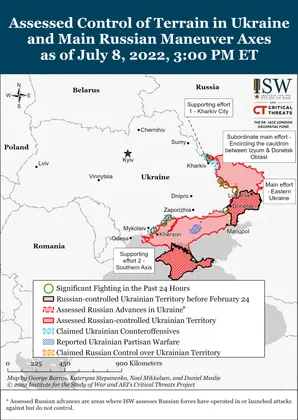Key Takeaways
- Russian forces continued to conduct limited offensive operations north of Slovyansk.
- Russian forces continued attempting to advance toward Siversk from Lysychansk but did not make any confirmed territorial gains.
- Russian forces launched assaults on Dementiivka to disrupt Ukrainian ground lines of communication (GLOCs) along the T2117 highway.
- Russian forces continued to launch assaults on settlements along the Kherson-Mykolaiv and Kherson-Dnipropetrovsk Oblast border to regain lost positions.
- Russian Federation Council approved a bill committing the Kremlin to paying veteran benefits to civilians involved in the Russian invasion of Ukraine.
- Russian occupation authorities continued to set conditions for the annexation of Donbas and southern Ukraine.
Luhansk Oblast Administration Head Serhiy Haidai stated that Russian forces are not conducting an operational pause as of July 8 and are continuing to shell settlements and deploy additional tank units to Donbas.
JOIN US ON TELEGRAM
Follow our coverage of the war on the @Kyivpost_official.
Haidai’s statement likely reflects confusion about the meaning of the expression “operational pause” and how such a “pause” actually manifests on the ground in a war. US military doctrine considers the role of operational pauses in warfighting and campaigning in some detail. It notes that “Normally, operational pauses are planned to regenerate combat power or augment sustainment and forces for the next phase.” It observes that “The primary drawback to operational pauses is the risk of forfeiting strategic or operational initiative.” It therefore recommends that “If pauses are necessary, the [commander] can alternate pauses among components to ensure continuous pressure on the enemy or adversary through offensive actions by some components while other components pause.” Soviet military theory regarded operational pauses in a similar fashion—sometimes necessary, but always dangerous.
The Russian military command, which announced an operational pause on July 7, has apparently recognized the need for a pause given the state of Russian forces at this point in the campaign.
The Russian troops that have completed the seizure of Severodonetsk and Lysychansk are clearly in need of regenerating combat power and building up supporting capabilities, including supply, before launching another large-scale offensive operation. Numerous reports from various sources show that they are engaged in both activities. They have naturally and necessarily ceased efforts to conduct large-scale offensive operations in this sector while they reorganized, reinforce, and resupply their tired troops—in other words, they are in an operational pause in this sector.

Kyiv Hit by Massive Drone Attack as Russian Strikes Target Multiple Ukrainian Cities
Recognizing the danger of allowing the Ukrainians to seize the initiative and go over to an offensive of their own, however, Russian forces continue to conduct more-limited offensive operations in this sector and elsewhere along the front line.
Those operations involve smaller Russian forces than had been involved in the attacks on Severodonetsk and Lysychansk pursuing more limited and localized objectives with less determination and willingness to take casualties compared with their behavior during the fights for the two cities. When the Russian military command has determined that it has adequately prepared for a renewed major offensive operation, it will likely resume larger-scale ground offensives with more troops and a greater determination than it is currently showing. The transition out of the operational pause may be gradual and difficult to discern at once, just as the transition into it appeared gradual. Skillful campaign design aims to achieve precisely such an effect in order to persuade the enemy that no pause is contemplated or underway, or that it will be too short to be of benefit to the enemy, and thereby convince the enemy that it does not have the opportunity to seize the initiative and go over to a counter-offensive of its own. Russian campaign design, inadequate as it has generally been, is nevertheless good enough to manifest this basic principle of operational art.
Russian milbloggers are continuing to show rhetorical opposition to the Kremlin by faulting the Russian Defense Ministry for making Russian logistics vulnerable to the Ukrainian strikes via US-provided HIMARS rocket systems.
Russian milbloggers are notably criticizing the Russian military command instead of expressing patriotic hatred toward Western suppliers of HIMARS as one would have expected of the ultra-nationalist, pro-war Telegram channels. Former Russian military commander Igor Girkin, an outspoken Russian nationalist who commanded militants during the Donbas war in 2014, stated that personnel of the Russian Defense Ministry’s logistics department should be tried for failing to disperse and camouflage ammunition depots. Russian milbloggers Starshe Eddy and Russian officer Aleksey Suronkin echoed similar concerns over the effectiveness of HIMARS, calling on Russian forces to adapt to new threats and strike back against Ukrainian forces. The continued trend of patriotic and pro-war Russian milbloggers blaming the Kremlin by default for setbacks and problems in the war may begin to create in effect a loyal opposition that could ultimately erode confidence in the milbloggers’ significant audience in Russia’s ability to win.
Authors: Kateryna Stepanenko, Frederick W. Kagan, and George Barros.
You can also highlight the text and press Ctrl + Enter






